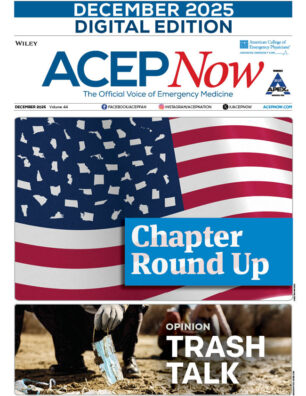Members of the ACEP Emergency Medicine Practice Committee (EMPC) (2010-2012) offer, in this article, information on patient satisfaction surveys including methodologies utilized, limitations of these methodologies, and thoughts on utilization of survey data for emergency physicians when working with hospital leaders on appropriate interpretation of scores and creation of environments conducive to quality care and patient satisfaction.
Explore This Issue
ACEP News: Vol 31 – No 08 – August 2012In service industries, including health care, satisfaction surveying is a common practice. Recently, the Centers for Medicare and Medicaid Services have embraced value-based purchasing as a methodology for apportioning entitlement health care resources, and identified patient satisfaction as a key marker of value. While Hospital Consumer Assessment of Healthcare Providers and Systems (HCAHPS) is based on the inpatient experience, hospital administrators have come to accept the ED as the “front door to the hospital” and expect their emergency medicine physician groups and ED staff to take the issue of patient satisfaction seriously. And yet the ED environment has unique challenges encountered when striving for patient satisfaction targets, including:
- The need to interact with patients without the benefit of an established physician-patient relationship.
- The need to inspire confidence and communicate concern for the patient and family in a short period of time.
- Long waits without the ability to monitor incoming patient flow.
- A wide range of presenting complaints complicated by diverse health status and demographics (Ann. Emerg. Med. 2000;35:426-34).
- Boarding of patients awaiting an inpatient bed that profoundly affects both the physical space and the personnel resources available for the ED patients who eventually are treated and discharged home.
Survey Methodology
HCAHPS is a CMS-driven process initiated in 2006. It has been described as the first national public and standardized survey that measures the patient’s perception of health care. Prior satisfaction surveys were used internally by hospitals. In contrast, HCAHPS compares hospitals publicly in relation to the patient’s perception of care. It is now being extended to include home health care and physician practices. Currently, the HCAHPS methodology revolves around surveys sent to a sample of adult patients between 48 hours and 6 weeks after discharge. Hospitals may use a survey vendor to acquire data or perform their own survey. The surveys may be performed by telephone, mail, or interactive voice recognition and are offered in different languages. The minimum target is 300 returned surveys per facility per year. HCAHPS excludes:
- Patients under 18.
- Patients who died in the hospital.
- Patients discharged to hospice.
- Patients discharged with a primary psychiatric diagnosis.
- Prisoners.
- Patients with international addresses.
- “No contact” patients.
There are many private survey companies that measure patient satisfaction, including Press Ganey, Avatar, NRC Picker, Professional Research Consultants (PRC), and Healthstream, among others. While these agencies send surveys to individual patients, data are usually collated for the hospital as an entity, although the data may be targeted to individual practitioners.
Survey Limitations
With the exception of rare survey systems performed in person and at discharge, satisfaction survey data are not completely random. Most health care satisfaction survey companies do not include patients admitted to the hospital or transferred out of the host hospital. In most cases, those patients receive an inpatient survey. Telephone-based surveys tend to skew the data away from non–English speakers and those who may not have a personal phone. Mail-based surveys eliminate those without permanent addresses and the illiterate. Children have their surveys filled out by parents or caretakers. Institutionalized patients may be unable to complete surveys independently and tend to be underrepresented.
Depending on how surveys are distributed and interpreted, frequent ED utilizers are either over- or underrepresented – commonly, ED surveys are not re-sent out to patients if they have been seen in the same ED within 90 days.
Surveys Here to Stay
Patient satisfaction surveys will increasingly be used in health care, with results tied to reimbursement. Satisfaction surveys are one of the few tools available to facilities, administrators, regulatory bodies, and providers to gauge the patient’s perception of care. The current move in health care is toward more transparency with incentives for high performers. ED leaders must be armed with the tools necessary to use survey information in the most productive manner. With a thorough understanding comes a greater ability to interpret the data, educate others, and drive to a better performance.
For the full research article on this topic, go to www.acep.org/patientsatisfaction.
Pages: 1 2 3 4 | Multi-Page




No Responses to “Emergency Department Patient Satisfaction Surveys”